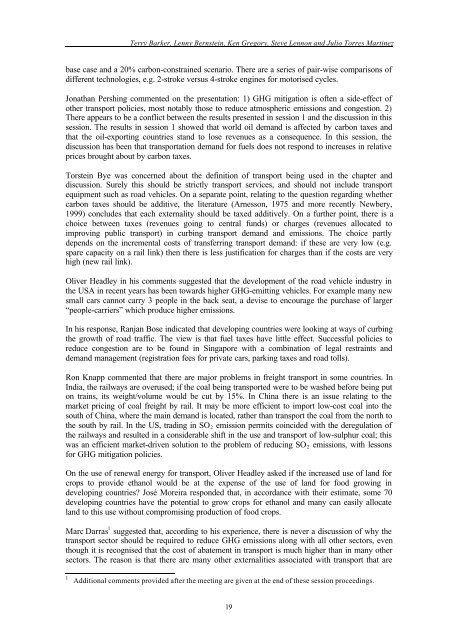sectoral economic costs and benefits of ghg mitigation - IPCC
sectoral economic costs and benefits of ghg mitigation - IPCC
sectoral economic costs and benefits of ghg mitigation - IPCC
Create successful ePaper yourself
Turn your PDF publications into a flip-book with our unique Google optimized e-Paper software.
Terry Barker, Lenny Bernstein, Ken Gregory, Steve Lennon <strong>and</strong> Julio Torres Martinez<br />
base case <strong>and</strong> a 20% carbon-constrained scenario. There are a series <strong>of</strong> pair-wise comparisons <strong>of</strong><br />
different technologies, e.g. 2-stroke versus 4-stroke engines for motorised cycles.<br />
Jonathan Pershing commented on the presentation: 1) GHG <strong>mitigation</strong> is <strong>of</strong>ten a side-effect <strong>of</strong><br />
other transport policies, most notably those to reduce atmospheric emissions <strong>and</strong> congestion. 2)<br />
There appears to be a conflict between the results presented in session 1 <strong>and</strong> the discussion in this<br />
session. The results in session 1 showed that world oil dem<strong>and</strong> is affected by carbon taxes <strong>and</strong><br />
that the oil-exporting countries st<strong>and</strong> to lose revenues as a consequence. In this session, the<br />
discussion has been that transportation dem<strong>and</strong> for fuels does not respond to increases in relative<br />
prices brought about by carbon taxes.<br />
Torstein Bye was concerned about the definition <strong>of</strong> transport being used in the chapter <strong>and</strong><br />
discussion. Surely this should be strictly transport services, <strong>and</strong> should not include transport<br />
equipment such as road vehicles. On a separate point, relating to the question regarding whether<br />
carbon taxes should be additive, the literature (Arnesson, 1975 <strong>and</strong> more recently Newbery,<br />
1999) concludes that each externality should be taxed additively. On a further point, there is a<br />
choice between taxes (revenues going to central funds) or charges (revenues allocated to<br />
improving public transport) in curbing transport dem<strong>and</strong> <strong>and</strong> emissions. The choice partly<br />
depends on the incremental <strong>costs</strong> <strong>of</strong> transferring transport dem<strong>and</strong>: if these are very low (e.g.<br />
spare capacity on a rail link) then there is less justification for charges than if the <strong>costs</strong> are very<br />
high (new rail link).<br />
Oliver Headley in his comments suggested that the development <strong>of</strong> the road vehicle industry in<br />
the USA in recent years has been towards higher GHG-emitting vehicles. For example many new<br />
small cars cannot carry 3 people in the back seat, a devise to encourage the purchase <strong>of</strong> larger<br />
“people-carriers” which produce higher emissions.<br />
In his response, Ranjan Bose indicated that developing countries were looking at ways <strong>of</strong> curbing<br />
the growth <strong>of</strong> road traffic. The view is that fuel taxes have little effect. Successful policies to<br />
reduce congestion are to be found in Singapore with a combination <strong>of</strong> legal restraints <strong>and</strong><br />
dem<strong>and</strong> management (registration fees for private cars, parking taxes <strong>and</strong> road tolls).<br />
Ron Knapp commented that there are major problems in freight transport in some countries. In<br />
India, the railways are overused; if the coal being transported were to be washed before being put<br />
on trains, its weight/volume would be cut by 15%. In China there is an issue relating to the<br />
market pricing <strong>of</strong> coal freight by rail. It may be more efficient to import low-cost coal into the<br />
south <strong>of</strong> China, where the main dem<strong>and</strong> is located, rather than transport the coal from the north to<br />
the south by rail. In the US, trading in SO 2 emission permits coincided with the deregulation <strong>of</strong><br />
the railways <strong>and</strong> resulted in a considerable shift in the use <strong>and</strong> transport <strong>of</strong> low-sulphur coal; this<br />
was an efficient market-driven solution to the problem <strong>of</strong> reducing SO 2 emissions, with lessons<br />
for GHG <strong>mitigation</strong> policies.<br />
On the use <strong>of</strong> renewal energy for transport, Oliver Headley asked if the increased use <strong>of</strong> l<strong>and</strong> for<br />
crops to provide ethanol would be at the expense <strong>of</strong> the use <strong>of</strong> l<strong>and</strong> for food growing in<br />
developing countries? José Moreira responded that, in accordance with their estimate, some 70<br />
developing countries have the potential to grow crops for ethanol <strong>and</strong> many can easily allocate<br />
l<strong>and</strong> to this use without compromising production <strong>of</strong> food crops.<br />
Marc Darras 1 suggested that, according to his experience, there is never a discussion <strong>of</strong> why the<br />
transport sector should be required to reduce GHG emissions along with all other sectors, even<br />
though it is recognised that the cost <strong>of</strong> abatement in transport is much higher than in many other<br />
sectors. The reason is that there are many other externalities associated with transport that are<br />
1<br />
Additional comments provided after the meeting are given at the end <strong>of</strong> these session proceedings.<br />
19
















